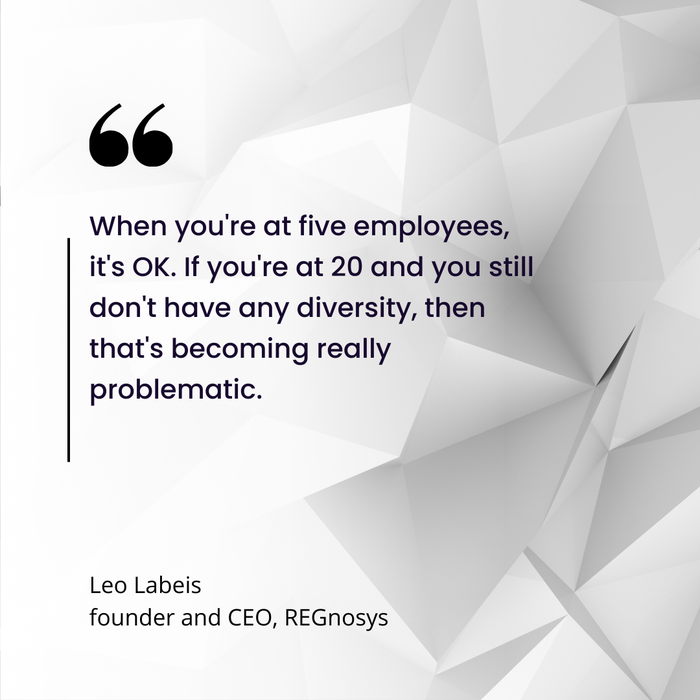Beyond a Bunch of Guys: How One IT Company Boosted Women's RepresentationBeyond a Bunch of Guys: How One IT Company Boosted Women's Representation
Regulatory technology firm REGnosys recognized that its lack of women employees was both wrong and bad for business. Here are the measures it took to increase female representation.

At a Glance
- The representation of women in computer science and IT has significantly declined in the last 40 years.
- Organizations like NCWIT, Women in Tech, and WISE are actively working to close the gender gap in tech.
- REGnosys has successfully increased its female representation from 0% to 38% by implementing intentional hiring practices.
In 1985, the year Super Mario Brothers hit the market and Back to the Future dominated the box office, 37% of the recipients of a bachelor's degree in computer science were women. In 2022, that number was 23%.
The representation of women working in the IT industry in 1984 stood at 35%. In 2023, it stood at just 27%, according to the National Center for Women & Information Technology.
"There are reasons that [women] don't stay," Dina Hackley-Hunt, executive director of diversity, equity, and inclusion (DEI) at Hollins University, a historically women's college, said in reaction to those statistics. "Do you really feel welcome? Is your voice really heard? And so that's that other kind of layer to having diversity is, you know, we're not supposed to all be the same. But how do people empower? How do they recognize the talent that we have?"
According to research by Accenture, 50% of women leave the tech industry by age 35, compared with just 20% in other industries. Fifty-two percent of women who work in the tech industry said that they have experienced gender bias or discrimination in the workplace.
In educating, hiring, and retaining women IT professionals, the gender gap in the tech industry has been widening rather than closing. This is a major problem for tech companies because they will miss many of the benefits of a diverse team.
However, many organizations are working toward closing the gender gap. In the United States, the National Center for Women & Information Technology (NCWIT) is working "to increase the meaningful and influential participation of all girls and women in computing," while internationally Women in Tech's goal is to "empower 5 million women and girls in STEM [Science, technology, engineering, and mathematics] fields by 2030." In the UK, WISE aims to "support their partners to achieve gender parity and benefit from better productivity, innovation, and business performance."
One tech startup, REGnosys, a regulatory technology firm in the UK (where women IT pros represent just 18.7% of the workforce), teamed up with WISE to help boost its own female representation from 0% to 38%. "We started like a lot of tech startups," Leo Labeis, REGnosys' founder and CEO, said in an interview with ITPro Today, "essentially just a bunch of guys."
The legacy of the bunch of guys gathering and starting tech companies is a well-worn story in the tech world and dominates our thinking of who makes up a tech company. When that bunch of guys need to grow their company, they often just find more guys.

This is explained partly by what researchers Brian J. Lucas, Laura M. Giurge, Zachariah Berry, and Dolly Chugh describe as the problem with informal hiring shortlists in fields where men dominate: Culturally, we automatically think that men are a better fit. From the moment a job is decided to be created, those in charge of filling it have "promising candidates in mind: one whom you remember from your alma mater's alumni event, another recommended by your previous mentor, and another whom your cousin recommended to you. Before you've even posted the formal job ad, you've created an informal shortlist of candidates who will — intentionally or unintentionally — receive more of your attention and more positive evaluations than those not on your informal list."
"It's about the realization that you're swimming upstream," Labeis said about REGnosys' decision to recruit women actively. "Society is already structured in a way where you have less girls, women coming out from STEM education, the deck of cards is already not stacked in [women's] favor. But what that means is if you don't make a very, very intentional, conscious choice that you want to do something to balance the scales, it's not going to sort itself out by magic."
The Decision to Grow More Diverse
REGnosys decided early on — when the company had about eight to 10 employees, all of whom were men — that it wanted to be far more diverse. Because "the more you wait, the harder it's going to be to swim against the current," Labeis said. "When you're at five employees, it's OK. If you're at 20 and you still don't have any diversity, then that's becoming really problematic."
With small numbers, REGnosys was able to radically improve its gender balance in a way that large companies have not been able to. For example, for all of Google's efforts, the company has only been able to change its gender balance from 29% in 2014 to 33.9% in 2023.
REGnosys' decision to start early allowed the company to gain momentum. Its first woman hired made a referral, and then came more, perhaps an example of short-circuiting the informal shortlist. Labeis said: "Once you start the trend, then sort of self-fulfilling, but the first one was, I think we got to the realization, OK, it's not just going to happen by magic. We have to not just tip the scale but step firmly on the scale."
A Road Less Traveled to Diversity
WISE, the company working together with REGnosys to help improve the representation of women in IT, recommends a 10-step framework to help "ensure women in science, technology, engineering and math (STEM) careers have the same opportunities to thrive as men." Among the steps WISE works on with organizations are Educate Your Leaders, where they learn to "visibly support and communicate the need for a diverse and inclusive workforce and be held accountable for delivering this," and Change Mindsets — "Changing the way people think and behave is a long-term challenge. Creating a culture that genuinely values and promotes diversity and inclusion requires not only a thorough review of company policies but zero-tolerance of bias and sexism at all levels of the company."
Much of this process of education is found in other fields too. In academia, Oregon State University's Search Advocate program uses a "Criteria Matrix" to help professorial search committees with a rubric to help, as Hackley-Hunt puts it, "make this as nonbiased as possible." In addition, job search committees can utilize search advocates "who've been trained to look at things in an unbiased way." Their objective is to help search committees "start thinking outside the box: What are other ways that we can bring people's strengths to the forefront that are creative, more creative? Like maybe you don't have this [qualification]? But do you have this? And can we work with that?"
Part of the biases and mindsets that REGnosys aimed to change was how it thought about the process of finding the right candidate. "If you are neutral," Labeis said, "which is, we're just going to hire the best candidate, we're going to try to make sure that we don't discriminate, etc. — if you just do that, it's not going to move the needle. So you have to do extra because, again, the deck is stacked, not in [women's] favor."
REGnosys' approach to attracting and retaining women began with carefully crafting job advertisements that highlighted the appealing aspects of the position. The company stressed its commitment to diversity and inclusion. It emphasized flexibility by offering remote work opportunities, a rarity in today's era of return-to-office mandates, appealing not only to women but also to older workers. REGnosys also offered parental leave and highlighted its commitment to diversity by allowing employees to choose whether to take time off or work on religious holidays.
However, REGnosys felt that this alone would not be enough to get the first woman through the process. Labeis said: "We took a group approach. And we explained to our recruiters what we wanted, and we said don't bother sending us male CVs, we won't to look at them. Which is, you know, I talked earlier about tipping the scale, right? That's a measure you can take by tipping the scale, and I'm not saying it's great or anything, but this is what it took to get there."
REGnosys aimed to make its interviews more inclusive by having each candidate interviewed by two people at the same time, one of whom would represent diversity. "It ensured that in the interview reports [that] you get a diverse perspective as well. From the point of view of the interviewee, it also reflects well on the company."
Diversity Efforts Are Bearing Fruit
REGnosys' deliberate work to bring women into the company has helped it achieve a 38% representation of women in the company (which currently numbers 20). In addition, REGnosys has found that these efforts have led to a broader talent pool to choose from: If all company employees were still all male, it would be very hard for REGnosys to be attractive to women applicants.
For REGnosys, bringing more women into the company has also been good for business. "It's particularly true in the industry we operate in," Labeis said. "It's probably true in many other industries, but our clients are financial institutions … lots of financial institutions that are centered around [affinity groups], women in technology, etc. And those are the people we sell to. So, that puts us at a little bit of an advantage when we are selling to those because we are seen as also doing the right thing there and effectively being more reflective of what they are also trying to achieve on their end."
Beyond financial institutions, too, a better gender balance has also been shown to improve a company's stock price.
"I'm of the age where, back in the day, it just wasn't sexy to be smart," Hackley-Hunt reflected upon hearing the statistics of women's representation in the IT industry. "We worked so hard to change that narrative. I worked with kids a long time before I came into higher ed. So I worked in elementary schools, middle schools, high schools, and we saw, around twelvish, girls would start telling themselves that it wasn't cute, it wasn't sexy, it wasn't attractive to be smart.
"They would be superstars killing it academically. And then, around middle school, we noticed they would dumb themselves down. It just hurts my ears to even say that out loud. But we saw it, you know, and that's psychological. Those are the social messages that our girls were getting. And so I thought we were on a better trajectory, that we understood that you do well in everything you do well in and let the chips fall where they may."
It is odd to write in 2024 that women's participation in IT professions has made no gains in the last 40 years. Fortunately, a number of groups are pushing to change the narrative both in the IT industry and in society in hopes of improving the representation of women in IT.
REGnosys makes one case for what it takes to get beyond just a bunch of guys.
About the Author
You May Also Like








.jpg?width=700&auto=webp&quality=80&disable=upscale)
